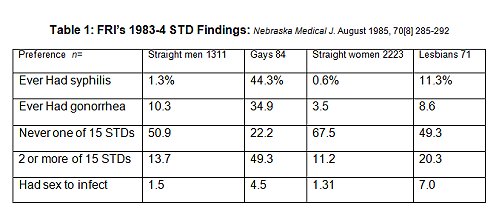
Paul Cameron
Whyte, writing in the Wall St J 1/27/23, said the FDA’s new policy will “subject all blood donors to the same set of questions, regardless of their gender or sexual orientation; [those] who have had anal intercourse with a new sexual partner in the last three months [won’t] be allowed to donate blood” thus allowing donations “from gay and bisexual men in monogamous relationships …without abstaining from sex.” Blood donors are disproportionately religious, yet they are to be treated "just the same" as gays or trans. Even though LGBTs test more mentally disturbed, the new policy pretends everyone is equally dangerous and equally responsible.
"Allow" suggests tight controls. But almost anyone who is vengeful CAN DONATE BLOOD IF THEY LIE – they haven’t broken the law [if a bad germ is detected they go on a deferral list]. So, protection consists of relying on donors to ‘tell the truth’ (and know a great deal about their partners – something often missing from gay encounters). The FDA is following almost the same playbook as it did in the 1980s with AIDS when partnered gays were also “allowed” to donate. Then new HIV infections ‘kept mysteriously appearing’ and gays were quoted saying "monogamy means something different to me;” “I’m monogamous with the guy I’m with;" or "I’m serially monogamous." Indeed, many studies of gay "marriages" indicate long-term fidelity is unusual and many couples allow others to "come in" or the partners to "go out." Unless the gay partners stay together 24/7, how would anyone but God know whether the relationship is "monogamous?"
Gay marriage was legalized in 2015. There is substantial evidence that married heterosexuals have fewer STDs and thus ‘less frequently contaminated’ blood. Why hasn’t the FDA cited studies finding married gay blood less dangerous than that of unmarried gays? The WSJ reported that the FDA has yet to publish the results of its study “of around 1,600 gay and bisexual men that looked at whether an individualized questionnaire would keep the blood supply safe.” I wonder why?
When AIDS began, many public health professionals were gay
I was friends with the STD officer for a large NE city in 1984. He attended a regional STD meeting with over 100 similar officers: when asked to stand if they were gay, he was shocked that at least 20% and perhaps as many as 25% stood (and remember, this was in public – it is likely that some who didn’t want to declare their sexuality stayed seated). Around the same time, an ex-CDC professional told me around 15-20% of his Atlanta peers were gay. In 1985, Surgeon General Koop estimated that around a fifth gay seemed "right." So, while I only have this informal evidence, even at the beginning of the HIV epidemic, it seems public health was, as with mental health, "tilted gay" by its heavy employment of homosexuals. The same appears to be true today.
FRI conducted a nationwide sexuality survey during 1983-4 as AIDS became an epidemic. Some of our STD findings, in what might have been the first random survey including homosexuals and non-homosexuals, are reproduced in Table 1. Included are reports of sex to infect: E.g., “When you knew you had an infectious disease, how often have you had sex to infect others?” For those reporting an infectious disease, almost 2% said they had tried to infect others.
Those embracing homosexuality generally reported more STDs and more deliberate infection of sex partners than heterosexuals of their sex. This finding would seem to bear on willingness to donate questionable or infected blood – a tiny fraction of the infected "want vengeance or ‘company.’" But what people say and what they do differ, plus having sex to infect a visible person is different than possibly infecting a stranger or strangers with contaminated or questionable blood.
As with almost every survey, "the data" was what people said. Not all gays claimed to have had an STD, and conversely, many heterosexuals reported them. Further, those who claimed to have deliberately infected via sex existed in each of the 4 categories of sexual preference. Study after study seems to underscore a substantial difference in socially-harmful activities and actions between straights and homosexuals, but on almost every score – disruptions, costs, molestations, etc. – we are talking about shades of grey rather than black v white. This consistency of more personal and more social disturbance by the homosexually-involved provides a solid reason to shape social policy toward suppressing homosexuality and promoting heterosexual marriage – laws are made for the "in general." But being heterosexually married does not assure being law-abiding etc., nor pursuing homosexuality the converse.
With extremely rare exceptions there is no way to verify what respondents report. The precise estimates in Table 1 are unlikely to be repeated in any given random survey today (or even then – samples vary in their outcomes). But almost all the results of well-done surveys show the same general order of social disruption and/or personal risk. Thus, whether catching STDs, abusing substances, criminality, or driving under the influence, gays usually register the most, straight men and lesbians often roughly tie, and straight women register the least.

In FRI’s survey, gays who said they had been "married" to another gay [informally, of course, at the time] reported more STDs than never-married gays. We tried several times to publish these cross-sectional findings since they suggested that "gay marriage" might not reduce the number of gay partners and therefore not reduce gays’ STDs, but we were unsuccessful. Even during the AIDS scare, it was almost impossible to get findings that failed to support LGBT goals published in professional journals. Today, the power of the LGBT movement is so strong it appears that the FDA jumps even higher to enhance homosexuals’ acceptance.
© Paul CameronThe views expressed by RenewAmerica columnists are their own and do not necessarily reflect the position of RenewAmerica or its affiliates.




















